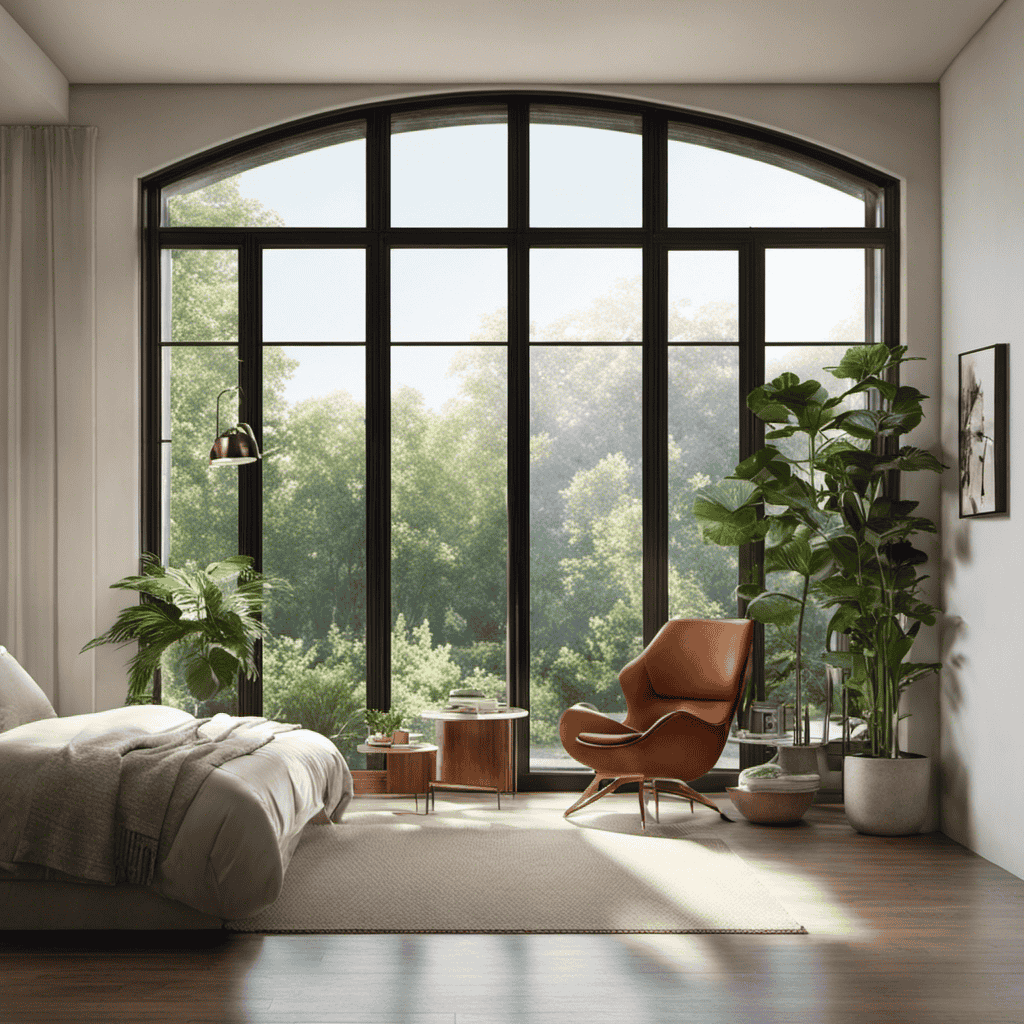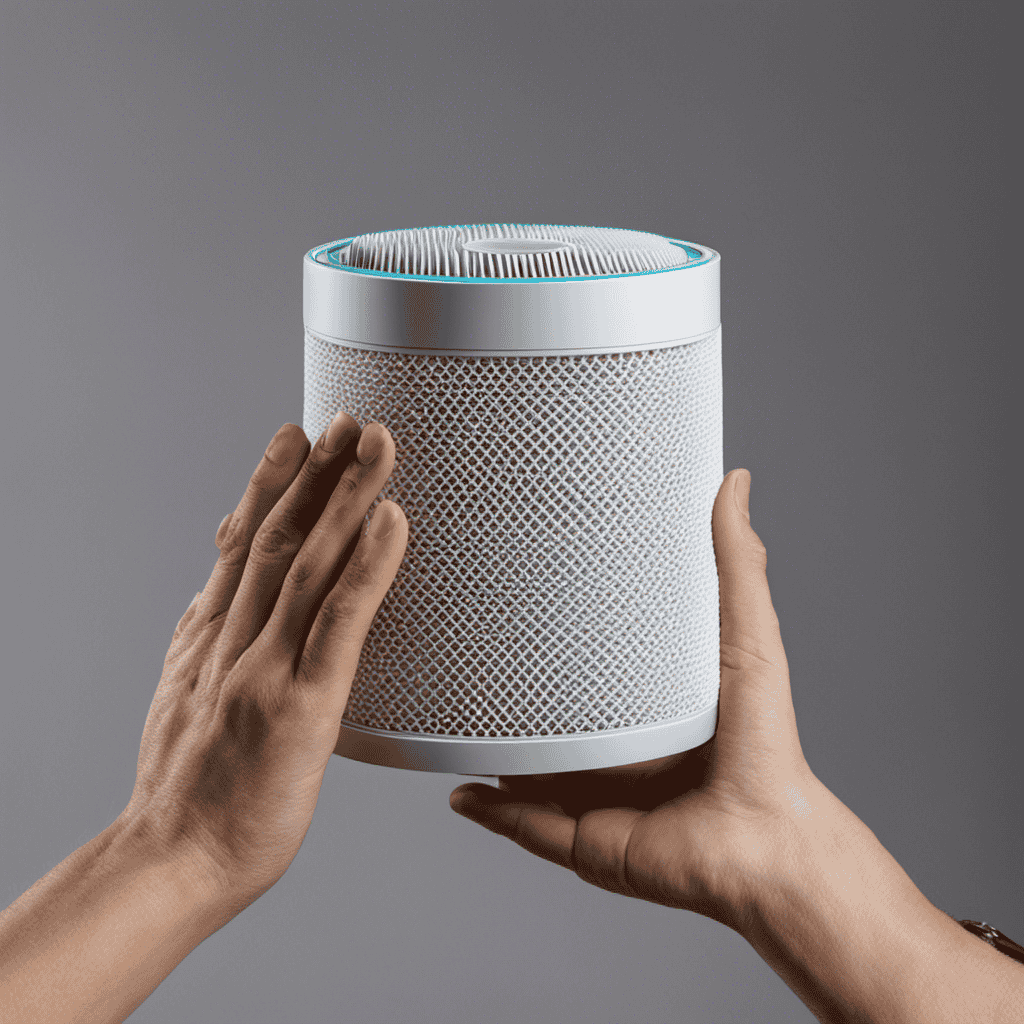Hey! Have you ever thought about whether your air purifier is really working as it should? Well, look no further. In this article, we’ll delve into the details of how air purifiers work and discuss various methods to evaluate their performance.
From monitoring filters to evaluating particle reduction, we’ll leave no stone unturned. So, if you’re ready to unravel the mystery of your air purifier’s performance, let’s get started!
Key Takeaways
- Air purifiers work by pulling in air from the surrounding environment and passing it through a series of filters to capture pollutants and allergens.
- To assess if an air purifier is working, it is important to measure air pollution levels before and after using the purifier and compare the improvement in air quality.
- Using a portable air quality monitor can provide accurate readings of indoor pollutants, helping to identify sources of air pollution and measure particulate matter (PM2.5) and volatile organic compounds (VOCs).
- Regularly monitoring and replacing the air purifier filters, such as the pre-filter, HEPA filter, activated carbon filter, and UV-C filter, is necessary for optimal performance and to ensure the removal of airborne particles.
Understanding Air Purifier Functionality
If you’re wondering how to know if your air purifier is working, it’s important to understand its functionality. Assessing air purifier effectiveness requires a clear understanding of the air filtration process.
Air purifiers work by pulling in air from the surrounding environment and passing it through a series of filters to capture pollutants and allergens. These filters typically include a pre-filter, a HEPA filter, and sometimes an activated carbon filter.
The pre-filter traps larger particles like dust and pet dander, while the HEPA filter captures smaller particles such as pollen and mold spores. The activated carbon filter helps to remove odors and chemicals from the air.
Assessing Air Quality Before and After
When it comes to assessing the effectiveness of air purifiers, there are several key points to consider.
First, measuring air pollution levels before and after using an air purifier is crucial in determining its impact. This allows for a direct comparison of the air quality improvement.
Additionally, understanding the effectiveness of air purifiers involves examining the actual purification process and the specific pollutants they target, evaluating their efficiency in removing these contaminants from the air.
Measuring Air Pollution Levels
To measure air pollution levels, you can use a portable air quality monitor that detects particulate matter and other pollutants. These monitors are designed to provide accurate readings of indoor pollutants, allowing you to assess the air quality in your immediate surroundings. With the help of these devices, you can easily identify the sources of air pollution, whether it’s coming from cooking activities, cleaning products, or even outdoor pollutants that have made their way indoors.
By measuring the levels of pollutants, such as PM2.5 and volatile organic compounds (VOCs), you can take necessary steps to improve the air quality and create a healthier environment for yourself and your loved ones.
Some benefits of using a portable air quality monitor include:
- Real-time monitoring, providing instant feedback on air pollution levels.
- Ability to track changes over time, allowing you to see the effects of different activities on air quality.
By detecting air pollution sources, you can:
- Identify specific areas or objects that contribute to poor air quality.
- Implement targeted strategies to reduce or eliminate these sources, improving indoor air quality overall.
Comparing Pre/Post Purification
Comparing the air pollution levels before and after purification can help determine the effectiveness of the air quality monitor. When evaluating the purification effectiveness, it is crucial to measure the air quality before and after the air passes through the filtration system. By conducting these measurements, we can assess the reduction in pollutant levels and determine how well the purifier is working.
It is essential to use standardized methods and equipment to ensure accurate and reliable measurements. Additionally, comparing different filtration methods can provide valuable insights into their efficiency in removing specific pollutants.
Effectiveness of Air Purifiers
If you want to determine the effectiveness of your air purifier, you should measure the air pollution levels before and after purification. This will help you evaluate the performance of your device and determine if it is effectively removing pollutants from the air.
To measure the air pollution levels, you can use an air quality monitor or a particle counter. These devices will provide you with accurate readings of the particulate matter and other pollutants present in the air.
When evaluating the air purifier’s performance, there are a few key factors to consider:
- Reduction in air pollution levels: Measure the difference in pollution levels before and after using the air purifier.
- Speed of purification: How quickly does the air purifier clean the air in the room?
- Coverage area: Does the air purifier effectively clean the air in the entire room or just a small area?
Monitoring Air Purifier Filters
Checking the air purifier’s filter regularly is crucial to ensure it’s effectively removing pollutants. Proper monitoring of filter maintenance is essential for maintaining the efficiency of an air purifier. By tracking the filter lifespan, you can determine when it needs to be replaced to ensure optimal performance. To help visualize this process, consider the following table:
| Filter Type | Lifespan (in months) |
|---|---|
| HEPA Filter | 6-12 |
| Activated Carbon Filter | 3-6 |
| Pre-Filter | 1-3 |
| UV-C Filter | 10-12 |
This table provides a general guideline for the lifespan of different types of filters commonly found in air purifiers. However, it’s important to note that actual filter lifespan may vary depending on factors such as air quality and usage. Regularly monitoring the filter’s condition and replacing it as needed will ensure that your air purifier continues to effectively remove pollutants and maintain clean indoor air quality.
Evaluating Airborne Particle Reduction
When it comes to evaluating the long-term effectiveness of air purifiers, comparing different filtration technologies is crucial. Each technology has its advantages and limitations, and understanding how they perform in reducing airborne particles is essential for making an informed decision.
In my experience, I have found that comparing filtration technologies can be done by considering the following factors:
-
Particle size removal: Different technologies have varying capabilities in capturing particles of different sizes. It’s important to know the specific particle size range that a particular technology can effectively filter.
-
Filtration efficiency: Evaluating the efficiency of various technologies in removing particles from the air is vital. Look for technologies that have high efficiency ratings to ensure effective purification.
-
Filter lifespan: Assessing the lifespan of filters used in different technologies is crucial for long-term effectiveness. Consider technologies that have filters with longer lifespans to minimize maintenance and replacement costs.
Measuring Air Purifier Noise Levels
When it comes to measuring air purifier noise levels, it is important to consider the established noise level standards. These standards help ensure that the noise emitted by air purifiers is within acceptable limits for various environments.
Additionally, understanding the impact of noise on sleep quality is crucial as excessive noise can disturb sleep patterns and lead to sleep deprivation.
Noise Level Standards
The noise level standards for air purifiers vary depending on the model and brand. When it comes to noise level regulations, there are a few key points to consider:
-
Noise level measurement: Air purifiers are typically measured in decibels (dB), which is the unit used to quantify sound intensity. The noise level is usually indicated on the product’s packaging or specifications.
-
Maximum permissible noise level: Different countries and regions have their own regulations regarding the maximum permissible noise level for household appliances. It’s important to check if the air purifier complies with these regulations to ensure a quieter environment.
Incorporating these noise level standards into air purifier design helps to ensure that the device operates at an acceptable noise level. This is important because excessive noise can negatively impact sleep quality and overall comfort in the home.
Impact on Sleep Quality?
To ensure a better sleep quality, you should consider the impact of noise levels on your air purifier. Noise can disrupt sleep patterns and lead to a decrease in overall sleep quality.
When choosing an air purifier, it is important to select one that operates quietly, especially if you plan on using it in your bedroom. Excessive noise can cause discomfort and make it difficult to fall asleep or stay asleep throughout the night.
Additionally, noise can have a negative impact on allergies and respiratory health. Loud air purifiers can potentially worsen allergy symptoms and irritate the respiratory system, especially for individuals with asthma or other respiratory conditions.
Therefore, it is crucial to choose an air purifier that not only effectively cleans the air but also operates quietly to promote a restful night’s sleep and minimize any negative impact on allergies and respiratory health.
Testing Air Purifier Odor Elimination
I’m not sure if the air purifier is working because I can still smell odors in the room. As someone who values clean air, I understand the frustration that comes with a malfunctioning air purifier.
To troubleshoot this issue, here are some steps you can take for air purifier maintenance:
-
Check the filter: Ensure that the filter is clean and properly installed. Over time, filters can become clogged with dust and other particles, reducing their effectiveness.
-
Inspect for leaks: Examine the unit for any cracks or gaps that may be allowing unfiltered air to escape. Sealing these leaks can improve the purifier’s performance.
Now, let’s delve into troubleshooting air purifier issues:
-
Reset the unit: Sometimes, a simple reset can resolve minor glitches. Refer to the manufacturer’s instructions on how to reset your specific model.
-
Adjust the settings: Increase the fan speed or activate additional features, such as ionizers or UV-C lights, to enhance odor elimination.
Assessing Air Purifier Energy Consumption
Assessing the energy consumption of your air purifier is an important step in understanding its efficiency and environmental impact. To do this, you should check the manufacturer’s specifications and compare it to other models on the market. By identifying the wattage of the air purifier and the average number of hours it operates per day, you can calculate its daily energy consumption in watt-hours. To convert this to kilowatt-hours (kWh), simply divide by 1000. This calculation allows for a comparison of energy efficiency between different models and estimation of associated energy costs. In addition to energy consumption, it’s also important to consider other factors such as air purifier features and performance when making an informed decision about the most energy-efficient option.
Comparing Air Purifier Brands and Models
When comparing air purifier brands and models, you can look for key features like HEPA filters and CADR ratings to determine which one suits your needs best. HEPA filters are highly effective at capturing small particles and allergens, making them ideal for individuals with allergies or asthma.
CADR ratings, on the other hand, measure the speed at which an air purifier can clean a specific size of room. This is important because you want an air purifier that can effectively clean the air in your desired space.
When evaluating air purifier features, it’s also important to consider the noise level, maintenance requirements, and additional features like timers or air quality sensors.
Lastly, comparing air purifier prices is essential to ensure you’re getting the best value for your money. By considering these factors, you can make an informed decision and choose the air purifier that meets your specific needs without breaking the bank.
Checking for Air Purifier Malfunctions
When it comes to ensuring that your air purifier is working effectively, there are a few key factors to consider.
One important aspect to evaluate is the lifespan of the filters. Over time, filters can become clogged with dust and pollutants, reducing their efficiency. It is recommended to check the manufacturer’s guidelines for filter replacement intervals and follow them accordingly.
Additionally, troubleshooting common issues can help identify any malfunctions in your air purifier. This may include checking for any loose connections or power supply problems, ensuring that the air intake and output vents are not blocked, and cleaning the unit regularly to prevent dust buildup.
By evaluating filter lifespan and troubleshooting common issues, you can ensure that your air purifier is functioning optimally and providing you with clean and fresh air.
Now, let’s explore the various health benefits that an air purifier can offer.
Recognizing Health Benefits of an Air Purifier
Using an air purifier can significantly improve the quality of the air you breathe, reducing the risk of allergies and respiratory issues. This is achieved through the air purifier’s ability to remove harmful particles and pollutants from the air.
The benefits of using an air purifier go beyond just immediate relief from allergies and respiratory problems. Here are a couple of reasons why investing in air purifier maintenance is crucial for long term health effects:
-
Regularly cleaning and replacing filters ensures that the air purifier continues to effectively remove pollutants from the air.
-
Proper maintenance prevents the accumulation of dust and mold within the purifier, which can lead to further health issues.
Taking care of your air purifier not only ensures its optimal performance but also safeguards your long term health. Seeking professional air purifier evaluation can further ensure that your purifier is functioning at its best and providing you with clean and healthy air.
Seeking Professional Air Purifier Evaluation
When it comes to evaluating the performance of an air purifier, seeking professional evaluation offers numerous benefits.
First and foremost, it ensures an accurate assessment of the air purifier’s effectiveness in improving indoor air quality.
Additionally, professional evaluation can provide valuable insights and recommendations for optimizing the performance of the air purifier, helping to create a healthier and cleaner living environment.
Benefits of Professional Evaluation
To determine if your air purifier is working effectively, you should consider the benefits of having a professional evaluation done.
Understanding the evaluation process and seeking professional advice can provide valuable insights into the performance of your air purifier.
Here are some key benefits of a professional evaluation:
-
Accurate assessment: A professional evaluation involves thorough testing and analysis to determine the efficiency of your air purifier. This ensures that you receive accurate information about its performance.
-
Identification of issues: A professional evaluation can help identify any potential issues or malfunctions in your air purifier. This allows you to address them promptly and ensure optimal performance.
-
Expert recommendations: Professionals can provide valuable advice on how to optimize your air purifier’s performance. They can recommend appropriate settings, maintenance routines, and even suggest upgrades if necessary.
-
Peace of mind: Having a professional evaluation done gives you peace of mind, knowing that your air purifier is working effectively and providing you with clean and healthy air.
Overall, a professional evaluation is essential in determining the effectiveness of your air purifier and ensuring that you make informed decisions about its maintenance and performance.
Accuracy of Assessment
An accurate assessment of your air purifier’s performance can be obtained through a professional evaluation. Evaluating the performance of an air purifier is crucial to ensure its effectiveness in improving indoor air quality. To measure the effectiveness of an air purifier, various factors need to be considered, such as the Clean Air Delivery Rate (CADR), the size of the room, and the type of pollutants present. The CADR indicates how efficiently the purifier can remove different pollutants from the air. A professional evaluation will assess these factors and provide an objective measurement of the air purifier’s performance. This evaluation can help determine if the air purifier is adequately cleaning the air and meeting your specific needs. By measuring the performance, you can make informed decisions about the efficiency of your air purifier.
| Factors to Consider | Measurement |
|---|---|
| Clean Air Delivery Rate (CADR) | Determines the efficiency of removing pollutants |
| Room Size | Considers the area where the air purifier is installed |
| Type of Pollutants | Identifies the specific pollutants present in the air |
Ensuring Optimal Performance
Evaluating the CADR, room size, and pollutants present is essential to ensure your air purifier is working effectively. To evaluate the filter efficiency, you can monitor the air quality over time and measure the reduction in pollutants. Troubleshooting common issues can also help optimize performance. Here are some tips:
- Check the filter regularly and clean or replace it as needed.
- Ensure the air purifier is placed in the appropriate position for maximum coverage.
- Keep doors and windows closed to prevent external pollutants from entering the room.
- Avoid placing the air purifier near obstacles that may obstruct airflow.
- Consider running the purifier on higher fan speeds during periods of increased pollution.
Frequently Asked Questions
Can an Air Purifier Remove Allergens Like Pollen and Dust From the Air?
Yes, an air purifier can remove allergens like pollen and dust from the air. It improves indoor air quality by efficiently capturing and filtering these particles, providing numerous benefits for allergy sufferers.
How Long Does It Typically Take for an Air Purifier to Noticeably Improve Air Quality?
It typically takes a few hours for an air purifier to noticeably improve air quality. When choosing an air purifier, consider your specific needs and the benefits it offers for removing allergens and improving indoor air quality.
Can an Air Purifier Eliminate Pet Odors From the Air?
An air purifier can effectively eliminate pet odors from the air, providing several benefits. It works by trapping and neutralizing the odor-causing particles, improving indoor air quality and creating a fresher environment.
Are There Any Potential Health Risks Associated With Using an Air Purifier?
There may be potential side effects associated with using an air purifier, but it depends on the individual and the specific purifier. It’s important to research and choose an effective air purifier for your needs.
How Often Should the Filters in an Air Purifier Be Replaced?
Filters in an air purifier should be replaced regularly to maintain its effectiveness. Signs that indicate the filters need to be replaced include reduced airflow and a decrease in the purifier’s ability to remove pollutants. The cost of replacement filters varies depending on the brand and model.
Is There a Specific Way to Test if My Air Purifier Is Effective?
If you’re wondering about your air purifier effectiveness test, there are a few ways to check its performance. You can use an air quality monitor to measure the improvement in air quality over time. Another option is to conduct a smoke or particle test to see how well the purifier works in real-time.
Conclusion
In conclusion, after thoroughly assessing the functionality of an air purifier and monitoring air quality, it becomes clear whether or not the purifier is working effectively. By evaluating filters and measuring particle reduction and noise levels, one can determine the purifier’s performance.
Additionally, comparing different brands and models, checking for malfunctions, and recognizing the numerous health benefits are crucial in making an informed decision about the air purifier.
Remember, ‘Seeing is believing,’ and with proper evaluation, you can ensure clean and healthy air in your surroundings.










